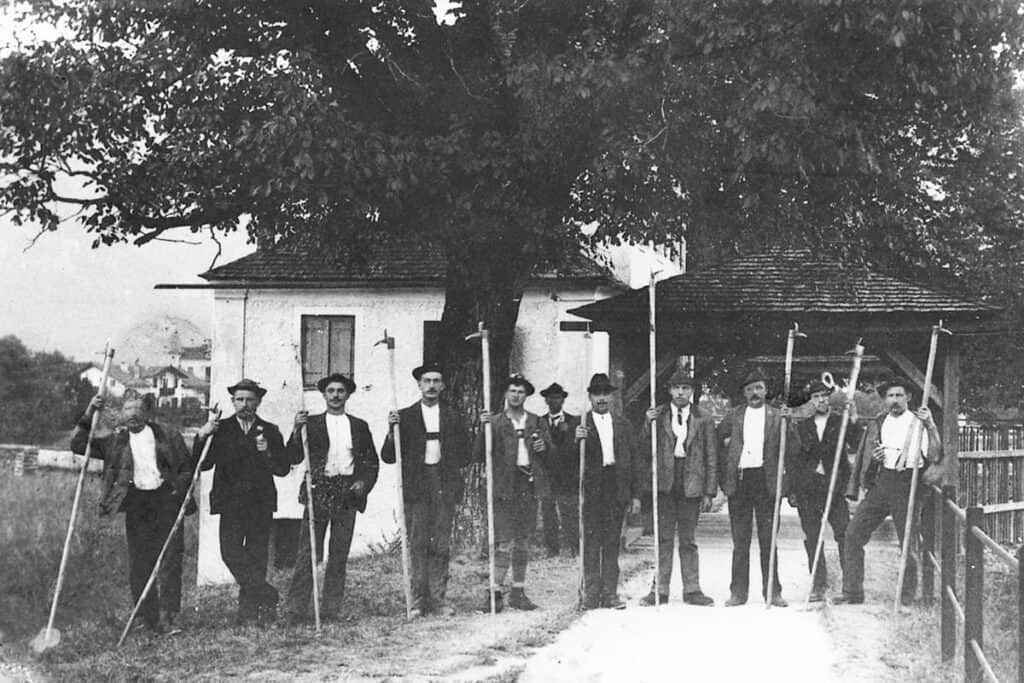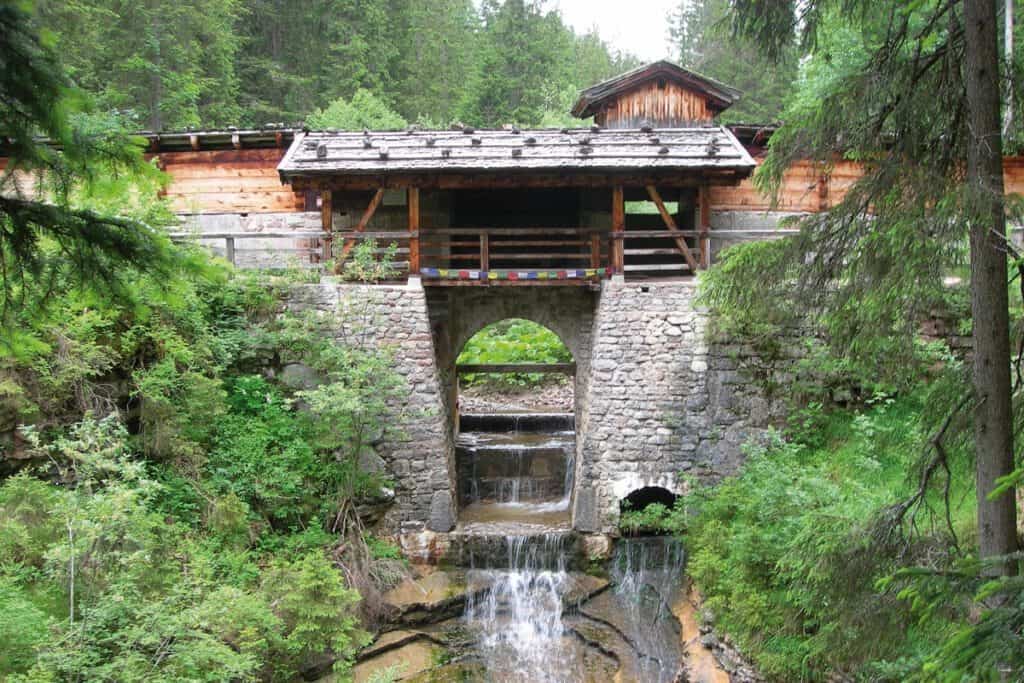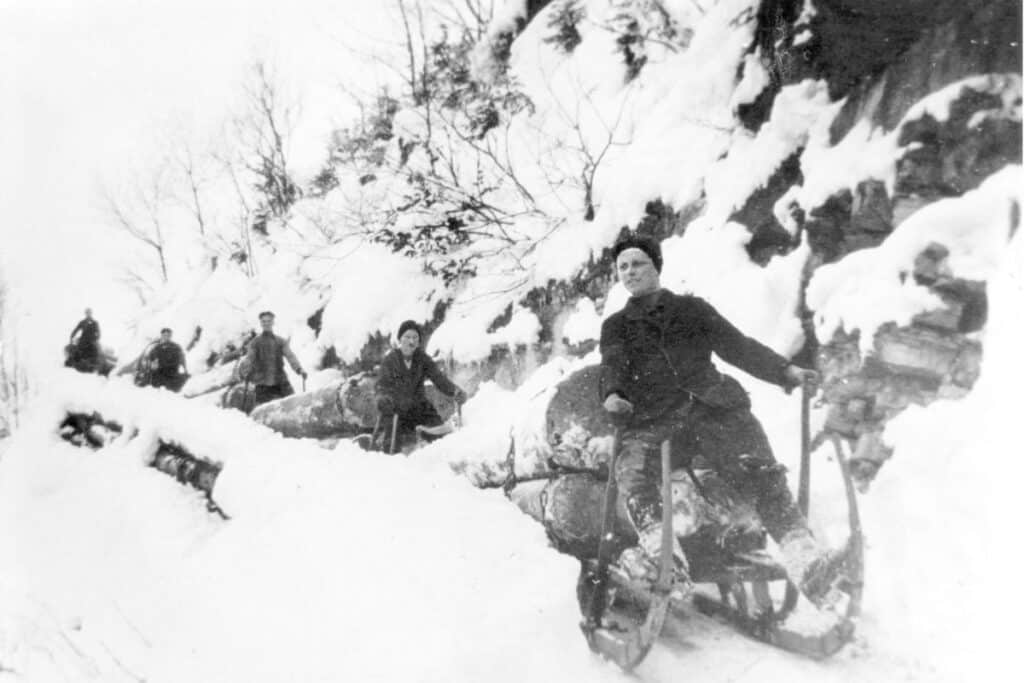The wood drift on the Unkener Muckklause
ON THE TRACKS OF THE WOOD DRIFTERS
The crystal clear water bubbles sprightly through the Muckklause in the Unkener Heutal. This is an idyllic spot where many e-bikers and hikers are lingering today. The dam, ‘klause’ in German, was used in the past to back up the water so that when it was opened, lumber would float down to the valley in the resulting flush of water. The Muckklause has been extensively restored so that even today it can tell us a lot about the dangerous work of the lumberjacks and wood drifters.
On the Trail – from the Kalchofengut to the Muckklause
On a visit to the Kalchofengut Museum in Unken I discover a long wooden pole with iron hooks on one end. I ask the custodian Sepp Auer what this pole is for and he explains the history of the wood drifters in the Salzburger Saalachtal. Because of the oldest, still-valid, European state treaty, the salt treaty of 1829, Bavaria owns around 18,000 hectares of forest in Austria. The wood was brought to Bavaria via drifting on mountain streams and the Saalach. The drifters were men who directed the wood with long poles in the water and sent it on its way.
It is still early morning on a beautiful summer’s day. Spontaneously I decide to set out on the trail of the Unken drifters to the Mucklause. I ride into the picturesque Heutal on my mountain bike. Contemplating the forests around me I remember Sepp Auer’s words, “The forests around Unken provided wood for the salt production in the saltworks in Bad Reichenhall for centuries. Lumberjacks and farmers’ hands felled large areas of the forest in winter, which belonged to the Bavarian ‘Saalforste’. Their tools were double-edged saws which they used to fell tree after tree. With heavily laden sleighs they brought the trunks through the deep forest to the Muckklause. These days there is barely any trace of the deforestation and I enjoy the shade of the trees on the way.
I ride over a saddle in the high forest and continue slightly uphill to the Kreuzbrücke. I turn off here and a lovely forestry road leads to the Winklmoosalm. About 100 metres after the tanzanger I park my bike and climb down to the former Muckklause wood drifting facility on foot. I enjoy the quiet here between the trees which is only disturbed by the monotone splashing of the stream. The Muckklause, renovated in 1975, is an imposing structure of stone and wood and I think back to Sepp Auer’s words, “The water in suitable streams was held back by stone dams and gates such as at the Mucklause at the confluence of the Mösererbach in Unken. This structure was first mentioned in records in 1626. The wood, which was brought to the dam by sleigh or via the specially built wood chutes, was shortened into logs here. A log measured three shoes – around 90 cm – and was pointed at both ends.“ Sepp Auer explained the reason why it had to be pointed, “Thanks to the points, the wood didn’t jam up in the water so easily and the dreaded ‘fox’ was prevented.“
Fear of the Fox
The pointed pieces of wood were thrown into the bed of the stream in front of the dam. When all of the wood had been prepared, the dangerous drift began with the melting of the snow in spring.
Drifting meant washing the wood down over the course of the stream and for this purpose around 14,000 cubic metres of water were backed up behind the gate of the dam in the so-called ‘dam yard’. “The dam was breached“, Sepp Auer said and gave this explanation during our conversation at the Kalchofengut, “The gate and the wooden supports of the dam were knocked out, whereupon the backed up water rushed out with enormous power, taking the piled up wood with it. Secondary dams on tributary streams along the main stream were also opened to enhance the flow of water. Then the wood drifters made sure no pile of wood backed up. Such a pile-up was called the ‘fox’ and the risky untangling of the wedged trunks cost some drifters their lives.“ The courageous men fought against the ‘fox’ with long poles which were pointed and hooked. On narrow walkways, such as those which can still be seen in the Seisenbergklamm, they poked and pulled the pieces of wood over the wild, bubbling water. One false move or a tiny slip and they fell into the ice-cold raging white water or they had to wade up to their waists in the water in order to steer the wood in the right direction. The enormous risk was the reason why only unmarried men were allowed to work as drifters. Many shrines in Unken bear witness to the numerous fatal accidents which occurred during drifting. On the other hand, votive tablets in the pilgrimage church Maria Kirchental depict miraculous survivals.
Coal Replaced the Wood Drift
After the narrow Klausbach was conquered, the wood found its way into the Saalach. Quietly but powerfully, the water carried the pieces of wood to the raking facility in Reichenhall. “There were always some losses, as not all of the wood which was thrown into the water in Unken arrived in Reichenhall. Part of it became wedged on the banks or was pulled out by the ‘wood fishers’“. The wood fishers were residents of the Saalach who were allowed to take a certain amount of wood out of the water for their own use with a drifting pole. The saltworks accepted this loss because on the one hand, the wood fishers prevented a pile up of wood and on the other hand, there was no alternative transport route which could be considered at that time. Drifting at the Muckklause took place until 1911. The change to the firing of the saltwork brewhouses with coal spelled the end for drifting.
The gentle babbling of the stream in the middle of the dense, green forest brings me back to the present – I take a last look at the historic structure of the Muckklause and wander back to the place where I left my mountain bike. Thoughts of the adventurous history of the Unkener wood drifters accompany me all the way back to the Kalchofengut.
more to the Museum Kalchofengut



